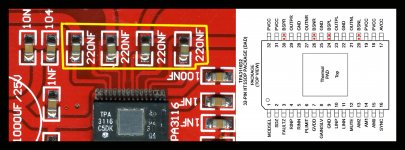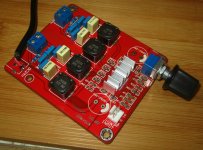Thanks nigelwright7557 !
My daughter has an 8 ohm 2.1 active speaker system to her PC. I wanna replace the bult-in chip amp to the TPA3116 module inside the subbass unit. I think the 22 uH beads would be optimal to these speakers.
My daughter has an 8 ohm 2.1 active speaker system to her PC. I wanna replace the bult-in chip amp to the TPA3116 module inside the subbass unit. I think the 22 uH beads would be optimal to these speakers.
Thank you muraxz! This is a good news!
I suggest try to attach a 12V accumulator ( or 9V battery !) to the board to exclude the the possible problem of the PS
What's the lenght of the LS wires?
I suggest try to attach a 12V accumulator ( or 9V battery !) to the board to exclude the the possible problem of the PS
What's the lenght of the LS wires?
Satellite speakers wires are 5 or 6 meters. I used a long electric cable for subwoofer which is not less than 11 meter. I will change this cable with a speaker cable soon.
how many clean watts are you all getting out of this chip with a 12V battery? I'm looking at this as an alternative to PP EL84.
Same as with any other bridged single rail amp on 12V.
I don't know what that is. May the Parts Express forum is a better place for newbies to get info.
I don't know what that is. May the Parts Express forum is a better place for newbies to get info.
Or Ohm's Law
Ppeak = V^2/Z
Where P is power, V is voltage, and Z is impedance
Pavg (or sometimes mistakenly called Wrms) = Ppeak/2
Naturally that would be the absolute peak level performance so expect this to be at over 10% distortion. For a more realistic figure take 80% of that.
So for 12V into 8 ohm speakers, you'd get Ppeak=18W, Pavg=9W, and Wrms=7.2W.
Last edited:
The ELNA white paper claim these to be "audio grade" and claim better audio quality without providing a shred of evidence why that would be so. Generally though, "audio grade" actually means low frequency range optimized which any part of a class D amp except for the input is not. If I was to choose, I'd go for hybrid electrolytic caps as the bulk cap as these have considerably lower ESR and up to 10 times better ripple current handling than an electrolytic cap for the same voltage and capacity. The small size penalty is overcome by the fact that you'd need smaller capacity.
Thanks for the qualified input (as always). I do realize that the audio industry is full of snake oil and the reason why I'm tempted to try the Silmic II's isn't due to ELNA's claims but rather what people around the web (including on this forum) claim to be hearing. But perhaps they are just under the influence of audiophile placebo?
Any specific hybrid electrolytic caps you would recommend me (preferably for through hole mounting)?
I might add that the speakers I'm driving are a relatively new pair of Q Acoustics 2050i (nom. impedance: 6Ω, min. impedance: 4Ω, sensitivity: 92dB).
So far I've tried the Sure TPA3110 boards stock and one with decoupling caps changed to Nichicon KZ 220uF 25V (same value as stock caps). My initial impressions are that the KZ's sound more "dry" and relaxed than the stock caps but perhaps at the expense of a tiny bit of top end clarity (caps are new and not "burned in" if that matters).
I slightly favor the sound of the board with the KZ's but even stock I'm really impressed with the clear sound and volume these 9.99$-smaller-than-a-credit card amps are able to produce. The only small gripe I have in order to make it my reference amp is a little bit of hissing (sharp s-sounds) so my main goal in terms of upgrading would be to eliminate these as much as possible. That's why I was looking at the Silmic II's due to their reputation for a warm sound with a soft top end. But perhaps different caps isn't the answer to combat hissing at all?
Last edited:
If I were to pin point a single element that by changing it could improve the vast majority of chip based class D amps, it would be the bootstrap capacitor as it's often forgotten that the output signal runs directly through it as part of the commutation current cycle of every single half cycle.
Often this is too far from the chip as maximum recommended distance is usually 5mm or less, often the value is downsized, the quality and type not considered with care, I could go on.
It should be a ceramic X7R capacitor of 10 times (or at the very minimum 4 times) the voltage rating of the amplifier to ensure frequency stability and lowest possible noise. Or alternatively a niobium oxide of 2 times the voltage rating of the amplifier for same.
Often this is too far from the chip as maximum recommended distance is usually 5mm or less, often the value is downsized, the quality and type not considered with care, I could go on.
It should be a ceramic X7R capacitor of 10 times (or at the very minimum 4 times) the voltage rating of the amplifier to ensure frequency stability and lowest possible noise. Or alternatively a niobium oxide of 2 times the voltage rating of the amplifier for same.
Last edited:
If I were to pin point a single element that by changing it could improve the vast majority of chip based class D amps, it would be the bootstrap capacitor as it's often forgotten that the output signal runs directly through it as part of the commutation current cycle of every single half cycle.
Often this is too far from the chip as maximum recommended distance is usually 5mm or less, often the value is downsized, the quality and type not considered with care, I could go on.
It should be a ceramic X7R capacitor of 10 times (or at the very minimum 4 times) the voltage rating of the amplifier to ensure frequency stability and lowest possible noise. Or alternatively a niobium oxide of 2 times the voltage rating of the amplifier for same.
What part would you recommend for replacing the stock bootstrap caps on the YJ TPA3116?
Attachments
Looks like 1206 pads to me those and as far as I know 220nF 250V X7R only comes in 1210 sizes or bigger but that should be possible to squeeze in. Search digikey or your regular supplier for what is readily available of those. I have no particular preference about brand. +-10% variants are fine.
Last edited:
Still haven't found the time to build the boards in cases. Did anyone of you notice the fact that the thermal pad is not soldered ? Thechip relies on the heatsink it seems.
Got in contact with Yuan Ying and they have a fitting case for the 2.0 boards too. It costs 30 US $. Looks OK.
Got in contact with Yuan Ying and they have a fitting case for the 2.0 boards too. It costs 30 US $. Looks OK.
Uh oh .... so the board is suitable for TPA3118 as well ?! There are plated through holes under the chip.
Here is a link to the original case:
http://www.yuan-jing.com/aluminium-...r-case/aluminium-case-power-amplifier-black-a
Please check the shipping costs !
Here is a link to the original case:
http://www.yuan-jing.com/aluminium-...r-case/aluminium-case-power-amplifier-black-a
Please check the shipping costs !
Last edited:
Uh oh .... so the board is suitable for TPA3118 as well ?! There are plated through holes under the chip.
Here is a link to the original case:
http://www.yuan-jing.com/aluminium-...r-case/aluminium-case-power-amplifier-black-a
Please check the shipping costs !
It looks fine, but input sockets are too close to the loudspeaker terminal. Necessary to use high quality shielded cables for input.
Looks like 1206 pads to me those and as far as I know 220nF 250V X7R only comes in 1210 sizes or bigger but that should be possible to squeeze in. Search digikey or your regular supplier for what is readily available of those. I have no particular preference about brand. +-10% variants are fine.
Thanks!
.... Did anyone of you notice the fact that the thermal pad is not soldered ? Thechip relies on the heatsink it seems....
The stock YJ 3116 2.0 board comes with a heatsink. This chip runs quite cool though and I've had one of them running for 4+ months straight (with a 21VDC supply) without a heatsink. The thermal protection has never even kicked in. While I don't recommend running one without it, I know that it's not going to immediately self destruct like many others would.
Attachments
The stock YJ 3116 2.0 board comes with a heatsink. This chip runs quite cool though and I've had one of them running for 4+ months straight (with a 21VDC supply) without a heatsink. The thermal protection has never even kicked in. While I don't recommend running one without it, I know that it's not going to immediately self destruct like many others would.
Let me second this. These chips run very, very cool.
For comparison, the HIfimediy T1 and T2 (both good sounding amps) run MUCH more warmly. I am not sure how long one would last in an enclosure even with serious ventilation.
The YJ TPA3116 occasionally becomes warm enough that you can sense that it is warmer than the ambient temperature, but not by much! I am running at a little under 20 volts.
One of mine is mounted in a miniature Lane cedar chest with just a few holes for ventilation. I can leave it on overnight and the enclosure is barely warm at all.
Looks like 1206 pads to me those and as far as I know 220nF 250V X7R only comes in 1210 sizes or bigger but that should be possible to squeeze in. Search digikey or your regular supplier for what is readily available of those. I have no particular preference about brand. +-10% variants are fine.
Just curious, can one tell what "kind" of capacitors are those on the board? Would you mind to elaborate why a ceramic one would be better?
Regards,
Just curious, can one tell what "kind" of capacitors are those on the board? Would you mind to elaborate why a ceramic one would be better?
Regards,
Electrolytic, tantalum, mylar and ceramic in order of highest frequency they will work with.
- Home
- Amplifiers
- Class D
- TPA3116D2 Amp

